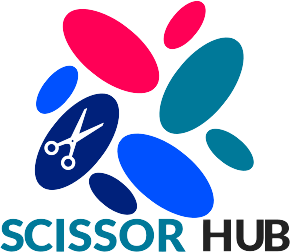Your Cart is Empty
In this article, we’ll be examining the various types of scissor edges and their blades. We’ll also explain how these edges and blades behave when cutting hair and their best use cases.
Hair scissors edges include the convex blade, the serrated blade, the sword blade, etc.
The Flat Blade or The Standard Blade

Also known as the Standard blade, the Flat blade is a single bevel blade. It is the most common type of hair scissors blade in the world.
Some refer to it as the original scissors blade. It is also the easiest blade to use, thus making it perfect for newbies.
It is also lightweight, flat, and it is easy to achieve a smooth cut. Its flat face is perfect for both comb face and hair face. The design of the beveled blade is quite outdated, but it remains relevant in today’s barbershop.
The flat blade is inexpensive. It is also very efficient. But it requires the application of more pressure and force than regular convex blades that can be found in the market. Also, it only works for simple cuts. It can’t work for intricate cutting styles.
The Sword Shape Blade
The sword shape blade has the unique feature of being shaped like a sword. This design enables power to be delivered at the tip. The barbing scissors blade has a convex edge and a sword blade.
The sword blade provides more precision and power. The shear of the sword has a ridge that runs all through the length of the blade.
Unlike other blades, whereby the power of the blade is dependent on the shear’s length, the sword blade produces powerful cuts regardless of the length. The unique shears enable the blade to achieve powerful cuts.
The sword blade works nicely and powerfully for haircuts.
The Concave Blade
The Concave scissor blade works nicely for a good sharp cutting. It has a cutting load, lower than other scissors, which helps it to cut hair easily.
Examples of concave blades are micro-serrated and serrated blades. Serrated blades and micro-serrated blades are often used along with bevelled edge blades.
Micro-serrated blades are best used by learners because they stop hair from sliding down the blade.
These blades are awesome for cutting dry hair and for slow detail cuts. They also work fine for scissor cutting and not comb cutting.
Because hairs get stuck on these blades, they aren’t appropriate for slice cutting. Even though the blades are used by learners, you should be wary as they can damage the cuticles when they cut through the hair.
The Convex Scissors Blades
The two types of convex scissors blades include the convex pro blade and the convex shape blade.
Convex Pro Blade
The Convex Pro Blade has the sharpest blade setting and angle of all. It is the best blade for the sharpest, smoothest cuts.
This blade has a point that is smaller than hair so that hairs won’t fly about. The blade is also perfect for the final, manual finishing for a suave cut. This is due to its powerful and large cross-section.
The powerful blade design makes sharp, smooth cutting easy to do. The curved outer blade improves the efficiency of the blade for slide cutting and intricate cuts. The convex pro blade also has a sharp angle that also enhances its output for sharp, smooth cuts.
The convex pro blade is very expensive and difficult to manufacture because of its intricate design and sharp blade.
The Convex Shape Blade
The Convex Shape blade is a recently designed and manufactured scissors blade. It is a sharp, soft scissors blade that can be used by both amateurs and professionals. It is an improvement over the regular convex blade.
This scissors blade works fine for any kind of haircut, but it is best used for slide cutting and texturizing.
There is a hone line on the hollow side of the blade’s edge. The hone line is incorporated onto the blade because the edges often rub each other on the edge’s hollow side.
The sharpness of the edges is responsible for this rubbing together. The hone line moves from the scissors tip to the back of the scissors.
The Width of Scissor Blades
The type of cutting a scissors is suitable for, and how the scissors cut is determined by the shape of the blade radius, especially the size of the radius and the cutting edge.
Long slim scissors have an edge angle of about 50 to 55 degrees, along with a blade line radius of 900 millimeters to 1000 millimeters.
These long slim scissors with narrow blades are best for heavy point cutting and blunt work.
There are several types of scissors blade widths. The width of a blade is directly proportional to its cutting power. Thin blade points are best for detailed jobs.
Scissor Blade Lines
Scissor blade lines range from curved lines to straight ones. Straighter blades are simply known as straight blades, while the curved blade is called the bamboo leaf. A regular blade is known as a willow blade.
The straighter a scissors blade, the easier it is to hold hair without the hair sliding. On the other hand, the curvier a scissors blade, the higher the quantity of hair that slides down when having a softer, smoother cut.
The bamboo leaf blade has the biggest curve, and it is used for slicing and slide cuts.

